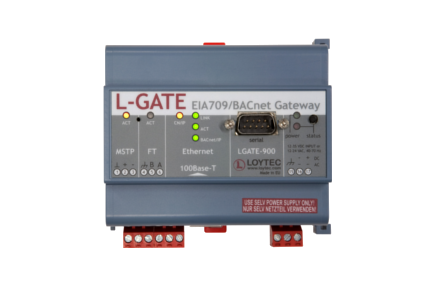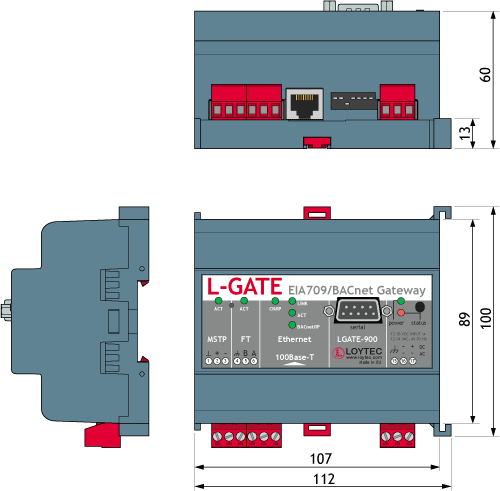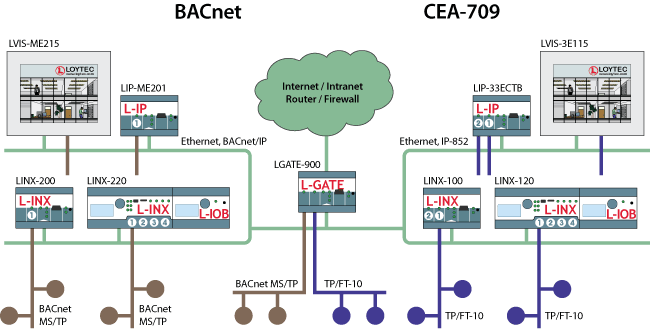Overview
LGATE-900 is a CEA-709/BACnet gateway which allows seamless integration of systems using both communication standards by mapping CEA-709 network variables (NVs) to standard BACnet server objects. LGATE-900 is fully compliant with the standards CEA-709, CEA-852, and EN 14908 (LonMark system) as well as ASHRAE 135-2008 and ISO 16484-5. Analog, binary, and multistate BACnet objects (input/output) are mapped to NVs based on the CEN/TS 15231:2005 standard. BACnet properties are automatically configured with default values from the SNVT self-description. Scalar NVs are mapped to one BACnet object each. Structured NVs are mapped to several BACnet object, one for each member (members can be selected individually). Each LGATE-900 can handle up to 750 BACnet Objects. Several devices can be installed in a network at the same time.
The configuration is done with an easy-to-use LNS® plug-in or stand-alone configuration tool. The connected networks can be scanned for network variables or BACnet objects. Installed as a plug-in, the configuration tool allows browsing the LNS® database. From the BACnet side, EDE-File import is supported.
Both static and dynamic Standard Network Variables (SNVTs) as well as User Defined Network Variables (UNVTs) and Configuration Properties (SCPTs, UCPTs) are supported. The configuration tool allows reading UNVTs from a device resource file and accessing Configuration Properties via LonMark file transfer. NVs can be bound or used as “external data points”(polled), which are configured with address information via the configuration tool. On the CEA-709 side, the LGATE-900 supports either LonMark IP-852 or TP/FT-10.
The BACnet server objects are accessible from the BACnet network where BACnet/IP or BACnet MS/TP is supported. In addition, LGATE-900 also includes client functions. For each server object a “client mapping” can be defined.
LGATE-900 supports management functions such as scheduling, alarming, and trending via corresponding BACnet objects. Scheduling parameters can be configured from remote using the configuration tool, the web interface or by downloading an XML file onto the device. Alarming includes functionality to generate, deliver, acknowledge, and display alarm conditions via the Web UI. The trending capability includes a data log of values and time stamps. Logged information is available through CSV file export for third party applications.
LGATE-900 features event-driven e-mail notification. This way, the user is promptly informed about alarm conditions like e.g. a specific status or an exceeded high-limit.
The following list resumes the main features of the device:
- Fully compliant with CEA-709, CEA-852 and EN 14908
- Fully compliant with ANSI/ASHRAE 135-2008 and ISO 16484-5
- Maps CEA-709 network variables to BACnet server objects based on CEN/TS 15231:2005
- Support of dynamically created network variables or static network variables
- Supports User Defined NVs (UNVTs) as well as Configuration Properties (SCPTs, UCPTs)
- Initializes BACnet properties from SNVT description
- Supports BACnet client mappings (WriteProperty, ReadProperty, COV Subscription)
- Supports trending, scheduling, and alarming locally and by referring to remote BACnet trendlog, schedule, and notification objects
- Event-driven e-mail notification
- Built-in OPC XML-DA Server
- Data point access via Web services
- Supports one TP/FT-10 or CEA-852 channel (configurable)
- Supports one BACnet MS/TP or BACnet/IP channel (configurable)
- Supports B-AAC (and in addition COV, Trending)
- Supports up to 750 BACnet objects plus trendlog, schedule, and notification objects
- Supports up to 750 BACnet objects plus trendlog, schedule, and notification objects
- BACnet object configuration via LNS® “1-button configuration” tool or fom XML file
- Built-in Web server for device configuration
- Network diagnostic LEDs
- 100Base-T connection
- Power Supply: 12-35 V DC / 12-24 V AC supply voltage
- DIN rail mountable
Installation
LINX is a device designed to be installed in DIN rail mounting cabinet and allows the use of different field buses for multiprotocol building control automation.
Integration
The L-GATE gateway is useful for Ethernet integration of indedpendent Lon and BACnet networks. Also a BACnet MS/TP channel and a Lon TP/FT-10 channel are used for field bus interconection, providing integration of multiple services like lighting, HVAC, blinds, etc.














 | Passatge Garrotxa, 6 | 08830 Sant Boi de Llobregat | Barcelona | Spain | Tel.: +34 93 652 55 21 | Fax +34 93 652 55 22
| Passatge Garrotxa, 6 | 08830 Sant Boi de Llobregat | Barcelona | Spain | Tel.: +34 93 652 55 21 | Fax +34 93 652 55 22